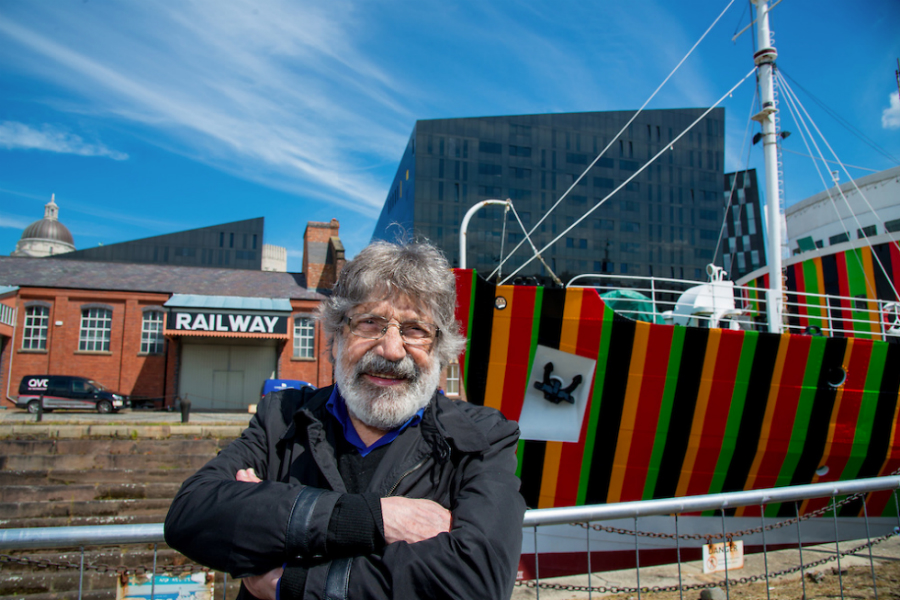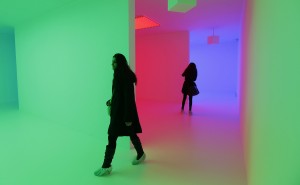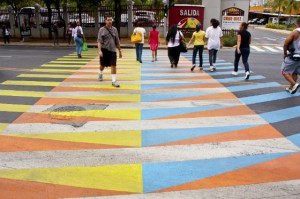The Big Interview: Carlos Cruz-Diez

His team call him The Maestro; a 91-year-old figurehead in the kinetic-optic art movement who has fundamentally changed our perception of colour. As he unveils a major new commission in Liverpool, we find out what makes Carlos Cruz-Diez tick…
Your new “sci-fi sculpture” Dazzle Ship (commissioned for this year’s Liverpool Biennial and the longer-term Monuments to the Future project) is now complete — what do you think of the finished result?
I think it’s fantastic — I was really surprised that it was so well done and also that we got such a sunny day. It’s a gift.
Your work with colour is usually so immersive; this project with dazzle camouflage on a docked ship is very different. How do you expect visitors to interact here?
The design was made so it could sail, so we could see it in the distance while it sailed. If you just walk from one side to the other you can really appreciate it.
I was thinking a lot about Relational Aesthetics when looking at your body of work; art with a social context. Do you subscribe to that ideology?
The whole purpose of my work and research was to make art go from being only contemplative to being participative. The whole purpose is to make people participate in the work. To be able to appreciate my art works, people have to walk through it; if you stop just in front, the piece dies. You are not able to see the effect, because they’re art pieces that happen in time and space.
Do you think that abstraction can change our perception of the world?
I’m not abstract, I’m concrete, because my proposition is evident. It’s from the phenomenological realm.
You were Professor of Typographical Design at the Central University of Venezuela (1958-60), and there seems to be a link between visual art and design in your work. Is one discipline more important than the other?
I am a painter; graphic design for me was a tool in order to survive and make a living. It also gave me information in order to pursue research into colour. Everything made in order to multiply image in colour from the 18-20th century gave me important information in order to reach the next step.
Your work Physichromie No. 123 will be exhibited at Tate Liverpool this summer (as part of the Biennial Claude Parent show). What can visitors expect?
I want people to realise that colour is not a certainty, but a circumstance. The notion we have about colour has always been a certainty; ‘Oh, red is red, green is green.’ And it’s not that; red is maybe red. It’s not the same if you hold an object under the sun as when you hold it in the shade. Colour is constantly changing to circumstance. And that’s what Physichromies are about; my whole research and work is about making people understand that. It will be a discovery, like a revelation. I want people to be happy; colour is effective. It’s like when you said when meeting us, ‘Red is my favourite colour!’ [Laughs]

Because colour is also associated with memory, yes.
There are thousands of shades of red, but you chose that one!
You’re often quoted as being an important part of the kinetic-op movement. What do you think about the other artists, your peers in this field?
I really appreciate all the artists before me, all the research in the movement which led to us today being able to use — as a tool in art — space and time and the moment.
The starting point of the movement could be Velázquez with Las Meninas, because that was the first time that there was another notion of space. Instead of painting from outside to the inside, he painted from the inside to the outside. I started seeing his work in the art school. There are many [artists I admire].
Can you describe your studio in Paris?
I am painting all the time! I consider myself a researcher and investigator; I’m constantly researching in order to broaden my knowledge on colour, which is the world I chose in order to make art. I chose colour as my main research as I thought there hadn’t been made yet a deep research on colour. The notions so far have been static; I decided to show that it wasn’t.
What triggered that since I was a child, for example, in the morning when I was having breakfast, the napkin on the table was white. When my grandmother set my food on it, when the sun came through the tinted window, the napkin took that colour. I realised I’d seen the colour, but it wasn’t painted on it. The colour didn’t have to be painted! There is another story. When I brought my daughter to the Saint Chapel in Paris, I told her to look at the coloured light from the windows [which reflected on us] — she thought she had to rub the colour off her hands.
How do you translate what you see into your work, so we can all see what you see?
People feel great affection for my work because colour is about affection. People are affected by the work in an emotional way. And what I can make for them is an information about life and happiness, and I make them particpate in my life, which is colour. I feel great pleasure in making the pieces, so I want people to feel that. I think that I have made it possible!
What contemporary artists do you think are making innovative work now?
I think that right now there is a revolution going on, because there is a creative recession, but also a recession in politics, the media, the art world. Something that is being prepared right now that we have no idea about. Every recession brings a revolution. Something great is coming. We’re living the end of the Duchamp academy.
Do you know what the next movement or art revolution will be?
If I knew, I would be doing it right now! [laughs]

Do you think all artists should be making artwork relevant to politics?
Art is implicitly political and social, because art is for people, art is to share. When you sing, it’s for people, when you dance, it’s for people. Which is the complete opposite to political ideologies, because in order to be heard we have to kill people, and art doesnt have to. No artist kills another one because he doesn’t like his artwork! There might be a lot of people that wont like the Dazzle Ship — I’ll send executioners! [Laughs]
I’ve heard that you’re planning to install a Crosswalks (of Addictive Colour, a work he has been recreating on pedestrian crossings since 1975) in the Liverpool One shopping centre — is this true?
Yes, we are just finalising the paperwork. The idea behind the Crosswalks is that they are institutional; you cannot touch them. There is only one solution; to walk across them. And when I change the [regular] crosswalks, then people think that anything is possible; anything can be in another way. That’s the scientific spirit. There’s a resemblance between scientists and artists, and it’s the thought of doubt; in scientific minds and artist minds, doubt is the common point, because nothing is just ‘true’. The truth is a generational consensus.
Which is interesting as the Liverpool One development turned public land into private land, removing public rights of access.
I am really happy about it [the installation location].
Mess with the system.
Haha, no, more like inform the system.
As told to Laura Robertson
Main portrait courtesy Mark McNulty
Dazzle Ship is a joint commission between Liverpool Biennial, Tate Liverpool and 14-18 NOW, in collaboration with National Museums Liverpool and you can see it until Winter 2015 – more here
Read In Pictures: The Making Of The Dazzle Ship
Liverpool Biennial opens 5 July-6 October 2014 — more here
See more of Carlos Cruz-Diez’s work at cruz-diez.com





